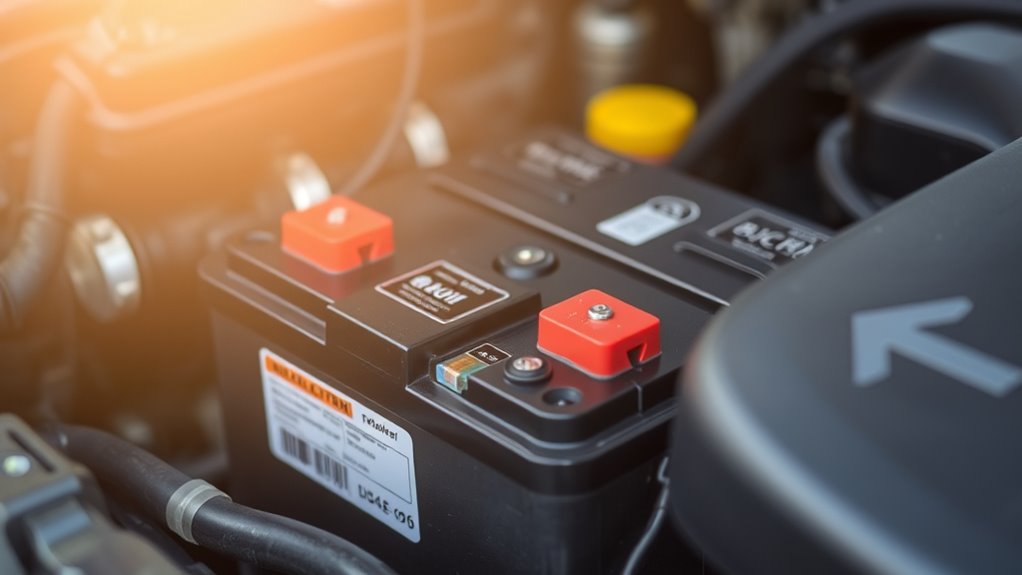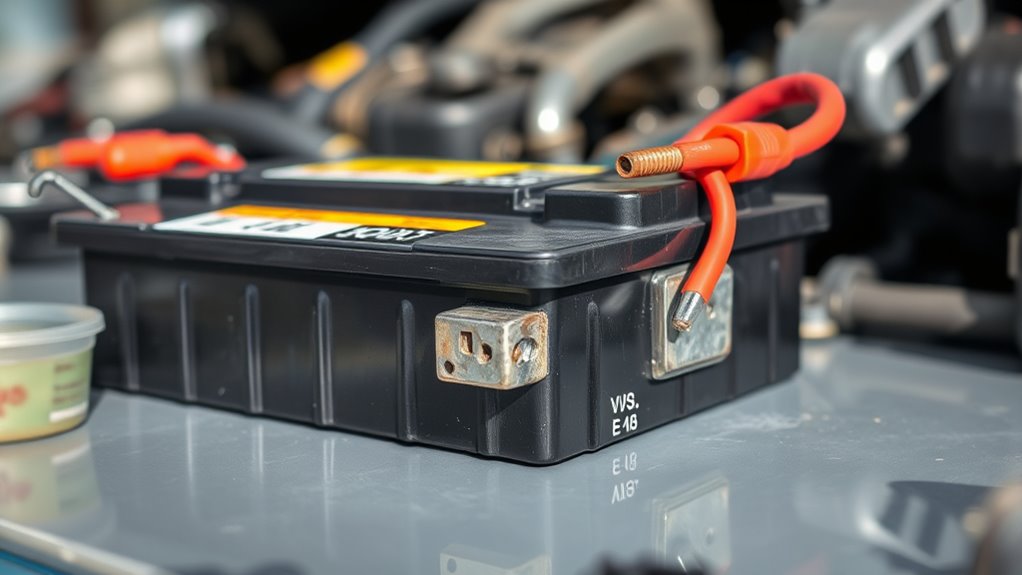Your car battery is essential for starting your vehicle and powering electrical systems. To keep it in good shape, regularly check and clean terminals, avoid long periods of disuse, and use proper chargers. Know that lead-acid, AGM, and gel batteries suit different needs and climates. Watch for signs like slow starts or swelling—usually after 3-5 years—to know when replacement’s due. Staying informed helps prevent breakdowns; explore further to learn more.
Key Takeaways
- Regularly check and clean battery terminals to prevent corrosion and ensure good electrical contact.
- Understand the main types—lead-acid, AGM, and gel—and select based on driving needs and climate.
- Test your battery periodically with a voltmeter or professional service to assess its health.
- Replace your battery when signs like swelling, leaks, or age over 3-5 years appear.
- Recycle old batteries responsibly at certified facilities to protect the environment and recover valuable materials.

Have you ever wondered what keeps your car running smoothly? It all comes down to your car battery. This essential component supplies the power needed to start your engine and run your vehicle’s electrical systems. To keep everything functioning properly, understanding basic maintenance, the different types of batteries, and when to replace them is vital. Proper charging techniques play a significant role in extending your battery’s lifespan. When your battery is weak, you might consider using a smart charger that adjusts the charging current based on the battery’s condition, preventing overcharging and damage. Avoid leaving your car unused for long periods, as this can cause the battery to discharge. If you notice slow engine cranking or dim lights, it’s time to check your battery and charging system. Regularly cleaning the terminals and ensuring they’re free of corrosion helps maintain good electrical contact, which is essential for efficient charging. Battery recycling is also an important aspect of responsible maintenance. When your battery reaches the end of its life, don’t just toss it in the trash. Instead, take it to a certified recycling facility. Recycling batteries prevents harmful chemicals from polluting the environment and allows valuable materials, like lead and plastic, to be reused. Many auto shops and recycling centers accept old batteries and often offer a small trade-in value, which can offset the cost of a new one. Knowing the different types of car batteries helps you make informed decisions. Lead-acid batteries are the most common, but there are variations like AGM (Absorbent Glass Mat) and gel batteries, which are more resistant to vibration and have better performance in extreme temperatures. Choosing the right type depends on your driving habits and climate conditions. When it’s time to replace your battery, look for signs like a swollen case, leaks, or if the battery is more than three to five years old. Regular testing with a voltmeter or having a professional check your battery’s health can save you from unexpected breakdowns. Additionally, understanding the importance of battery maintenance can extend the life of your vehicle’s power source. Remember, maintaining proper charging techniques and responsibly recycling your old batteries not only keeps your vehicle running smoothly but also protects the environment. Stay attentive to your battery’s condition, and don’t hesitate to seek expert advice if you’re unsure about its status. A well-maintained battery ensures your car starts reliably and runs efficiently, giving you peace of mind on every trip.
Frequently Asked Questions
How Do Extreme Temperatures Affect My Car Battery?
Extreme temperatures can seriously impact your car battery’s performance. Cold weather causes your battery’s chemical reactions to slow down, reducing its capacity, while hot temperatures accelerate internal corrosion. To combat this, make certain proper battery insulation and consider temperature compensation features that adjust charging levels accordingly. This helps maintain ideal battery function and prolongs its lifespan, especially during extreme weather conditions you might encounter.
Can I Jump-Start a Frozen Battery Safely?
You can jump-start a frozen battery, but you need to prioritize safety. First, check if the battery is cracked or swollen—if so, don’t attempt to jump-start it. Use proper battery insulation to protect yourself from sparks or leaks. Connect the jumper cables carefully, ensuring correct polarity, and avoid sparks. If you’re unsure, it’s safer to call roadside assistance to prevent damage or injury.
What Is the Average Lifespan of a Car Battery?
Wondering about your battery’s lifespan? Typically, a car battery lasts around three to five years, depending on driving habits, climate, and care. You should watch for wear and tear, as battery capacity diminishes with time. Frequent charging cycles and consistent use can extend its life, but eventually, corrosion and capacity loss require replacement. Regular checkups help you catch concerns early, keeping your car cruising comfortably.
Are There Eco-Friendly Battery Disposal Options?
You’re wondering if there are eco-friendly battery disposal options? Yes, many recycling programs offer green disposal methods, ensuring batteries are safely processed and valuable materials are recovered. You can bring your used batteries to certified recycling centers or participate in manufacturer take-back programs. By doing so, you promote environmental sustainability and reduce hazardous waste. Always check local regulations and choose proper recycling options to support eco-friendly practices.
How Does a Dual Battery System Work?
Imagine your vehicle’s electrical system as a busy highway, with a dual battery setup acting like a second lane to ease traffic. It manages electrical load efficiently, preventing your main battery from overworking. This setup supplies power to accessories without draining your primary battery, especially when you’re camping or off-grid. It’s a smart way to keep your vehicle running smoothly, even when you’re demanding more power from your system.
Conclusion
Taking care of your car battery guarantees reliable starts and avoids unexpected breakdowns. Regular maintenance like checking terminals and testing your battery can prevent costly repairs down the line. Think of it like watering a plant—you need to nurture it consistently to keep it thriving. Even if you’re busy, a quick visual inspection can save you from being stranded. Stay proactive, and your battery will serve you well through every journey.









